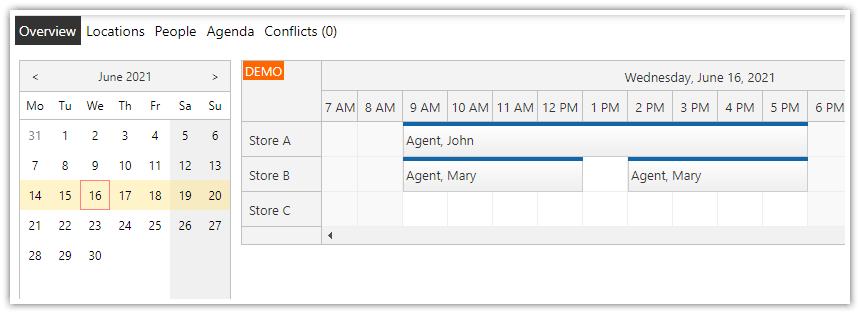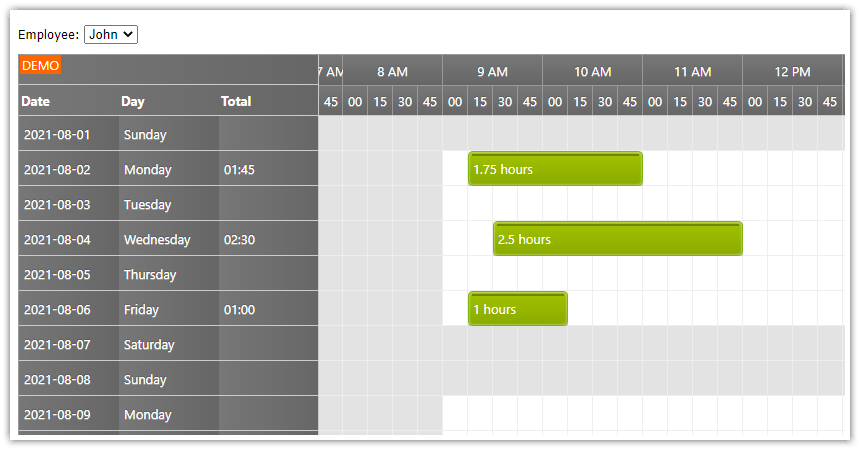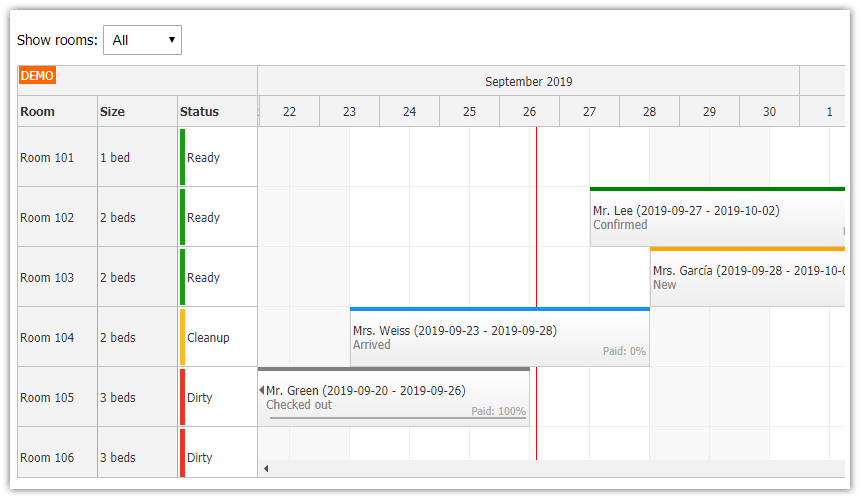Sample Project
The sample project includes:
C# Source Code
VB.NET Source Code
Visual Studio 2019 Solution
License
Licensed for testing and evaluation purposes. You can use the source code of the tutorial if you are a licensed user of DayPilot Pro for ASP.NET WebForms.
Note
There is a new version of this tutorial available:
This tutorial is also available for PHP:
Requirements
.NET Framework 4.0 or higher
Visual Studio 2019 or higher (optional)
Microsoft SQL Server (Express)
Features
This tutorial shows how to create a restaurant table reservation web application using ASP.NET scheduler control.
Displaying tables in restaurant sections (Inside, Terrace)
Displaying table seats in an additional column
Disabling drag and drop operations for parent nodes (restaurant sections)
Time headers (day, hour, minutes)
Highlighting conflicting reservations
Reservation filter (find frees table by time and/or number of people)
1. Displaying Tables in Rows

We will load the restaurant tables from the [Location] database table. The tables are located in sections (Inside, Terrace) - the section id is stored in [LocationParent] field.
The sections will be displayed as parent nodes, the tables as their children:
C#
protected void Page_Load(object sender, EventArgs e)
{
if (!IsPostBack)
{
LoadResources();
}
}
private void LoadResources()
{
DataTable locations = new DataManager().GetTables();
DayPilotScheduler1.Resources.Clear();
foreach (DataRow location in locations.Rows)
{
int id = Convert.ToInt32(location["LocationId"]);
Resource r = new Resource((string)location["LocationName"], null); // using null for resources that can't be used
r.IsParent = true; // marking as parent for the case that no children are loaded
r.Expanded = true;
DayPilotScheduler1.Resources.Add(r);
DataTable rooms = new DataManager().GetLocations(id, Filter.Seats);
foreach (DataRow dr in rooms.Rows)
{
Resource c = new Resource((string)dr["LocationName"], Convert.ToString(dr["LocationId"]));
r.Children.Add(c);
}
}
}
VB.NET
Protected Sub Page_Load(ByVal sender As Object, ByVal e As EventArgs)
If Not IsPostBack Then
LoadResources()
End If
End Sub
Private Sub LoadResources()
Dim locations As DataTable = (New DataManager()).GetTables()
DayPilotScheduler1.Resources.Clear()
For Each location As DataRow In locations.Rows
Dim id As Integer = Convert.ToInt32(location("LocationId"))
Dim r As New Resource(CStr(location("LocationName")), Nothing) ' using null for resources that can't be used
r.IsParent = True ' marking as parent for the case that no children are loaded
r.Expanded = True
DayPilotScheduler1.Resources.Add(r)
Dim rooms As DataTable = (New DataManager()).GetLocations(id, Filter.Seats)
For Each dr As DataRow In rooms.Rows
Dim c As New Resource(CStr(dr("LocationName")), Convert.ToString(dr("LocationId")))
r.Children.Add(c)
Next dr
Next location
End Sub
The header row width can be set using RowHeaderWidth property (in pixels):
RowHeaderWidth="120"We will add RowHeaderWidthAutoFit to make sure that the row header width is increased automatically to fit the row header text (the table or section name):
RowHeaderWidthAutoFit="true"2. Displaying Table Seats in an Additional Column

The number of table seats is stored in [LocationSeats] field of the [Location] table. We will modify the LoadResources() method to add a new column with the seat count.
C#
foreach (DataRow dr in rooms.Rows)
{
Resource c = new Resource((string)dr["LocationName"], Convert.ToString(dr["LocationId"]));
c.Columns.Add(new ResourceColumn(dr["LocationSeats"] + " seats"));
r.Children.Add(c);
}
VB.NET
For Each dr As DataRow In rooms.Rows
Dim c As New Resource(CStr(dr("LocationName")), Convert.ToString(dr("LocationId")))
c.Columns.Add(New ResourceColumn(dr("LocationSeats") & " seats"))
r.Children.Add(c)
Next dr
The columns can be specified using <HeaderColumns>:
<DayPilot:DayPilotScheduler
ID="DayPilotScheduler1"
runat="server"
...
>
<HeaderColumns>
<DayPilot:RowHeaderColumn Title="Name" />
<DayPilot:RowHeaderColumn Title="Capacity" />
</HeaderColumns>
</DayPilot:DayPilotScheduler>The automatic row header width adjusting (RowHeaderWidthAutoFit) will work for multiple columns as well.
3. Disabling Parent Nodes

The scheduler parent tree nodes that represent restaurant sections (e.g. "Terrace") are disabled for drag and drop operations using TreePreventParentUsage property:
TreePreventParentUsage="true"The cells are marked with prefix_cellparent CSS class (where "prefix" is replaced with Theme value).
.scheduler_8_cellparent {
background-color: #f8f8f8;
}4. Time Headers (Day/Hour/Minutes)

The grid cell duration is set to 15 minutes using CellDuration property:
CellDuration="15"By default, the header displays the column header and one level of column groups (CellGroupBy property). We will use two column header groups (day and hour):
C#
protected void Page_Load(object sender, EventArgs e)
{
if (!IsPostBack)
{
DayPilotScheduler1.TimeHeaders.Clear();
DayPilotScheduler1.TimeHeaders.Add(new TimeHeader(GroupByEnum.Day, "dddd, d MMMM yyyy"));
DayPilotScheduler1.TimeHeaders.Add(new TimeHeader(GroupByEnum.Hour));
DayPilotScheduler1.TimeHeaders.Add(new TimeHeader(GroupByEnum.Cell));
}
}
VB.NET
Protected Sub Page_Load(ByVal sender As Object, ByVal e As EventArgs)
If Not IsPostBack Then
DayPilotScheduler1.TimeHeaders.Clear()
DayPilotScheduler1.TimeHeaders.Add(New TimeHeader(GroupByEnum.Day, "dddd, d MMMM yyyy"))
DayPilotScheduler1.TimeHeaders.Add(New TimeHeader(GroupByEnum.Hour))
DayPilotScheduler1.TimeHeaders.Add(New TimeHeader(GroupByEnum.Cell))
End If
End Sub5. Conflicting Reservations

The reservation conflicts are not checked in advance. It is allowed to create a reservation for a table and time that are reserved already.
Instead, all reservations store a priority date in the [AssignmentPriority] field. This field is updated to the current time whenever the reservation resource (table) is changed.
C#
public void MoveReservation(int id, DateTime start, DateTime end, int location)
{
DataRow original = GetReservation(id);
// if the reservatino table was changed, update the priority
bool tableChanged = (Int64)original["LocationId"] != location;
if (tableChanged) // update the priority
{
using (var con = CreateConnection())
{
con.Open();
var cmd = CreateCommand("update [Assignment] set [AssignmentStart] = @start, [AssignmentEnd] = @end, [LocationId] = @location, [AssignmentPriority] = @priority where [AssignmentId] = @id", con);
AddParameterWithValue(cmd, "id", id);
AddParameterWithValue(cmd, "start", start);
AddParameterWithValue(cmd, "end", end);
AddParameterWithValue(cmd, "location", location);
AddParameterWithValue(cmd, "priority", DateTime.Now);
cmd.ExecuteNonQuery();
}
}
else
{
using (var con = CreateConnection())
{
con.Open();
var cmd = CreateCommand("update [Assignment] set [AssignmentStart] = @start, [AssignmentEnd] = @end, [LocationId] = @location where [AssignmentId] = @id", con);
AddParameterWithValue(cmd, "id", id);
AddParameterWithValue(cmd, "start", start);
AddParameterWithValue(cmd, "end", end);
AddParameterWithValue(cmd, "location", location);
cmd.ExecuteNonQuery();
}
}
}VB.NET
Public Sub MoveReservation(ByVal id As Integer, ByVal start As Date, ByVal [end] As Date, ByVal location As Integer)
Dim original As DataRow = GetReservation(id)
' if the reservatino table was changed, update the priority
Dim tableChanged As Boolean = DirectCast(original("LocationId"), Int64) <> location
If tableChanged Then ' update the priority
Using con = CreateConnection()
con.Open()
Dim cmd = CreateCommand("update [Assignment] set [AssignmentStart] = @start, [AssignmentEnd] = @end, [LocationId] = @location, [AssignmentPriority] = @priority where [AssignmentId] = @id", con)
AddParameterWithValue(cmd, "id", id)
AddParameterWithValue(cmd, "start", start)
AddParameterWithValue(cmd, "end", [end])
AddParameterWithValue(cmd, "location", location)
AddParameterWithValue(cmd, "priority", Date.Now)
cmd.ExecuteNonQuery()
End Using
Else
Using con = CreateConnection()
con.Open()
Dim cmd = CreateCommand("update [Assignment] set [AssignmentStart] = @start, [AssignmentEnd] = @end, [LocationId] = @location where [AssignmentId] = @id", con)
AddParameterWithValue(cmd, "id", id)
AddParameterWithValue(cmd, "start", start)
AddParameterWithValue(cmd, "end", [end])
AddParameterWithValue(cmd, "location", location)
cmd.ExecuteNonQuery()
End Using
End If
End SubThis priority field (AssignmentPriority) is used for sorting the overlapping events using EventSortExpression property:
EventSortExpression="AssignmentPriority"All reservation boxes (events) are marked with prefix_event_lineX CSS class, depending on the line number inside of a table (resource) row. This way, we can use red color for all events that not are displayed in line 0:
.scheduler_8_event_inner
{
background: #ed3b00;
}
.scheduler_8_event.scheduler_8_event_line0 .scheduler_8_event_inner
{
background: #09b2ef;
}
This will display reservations (events) with the highest priority on line 0 and highlight all reservations on the following other lines.
6. Reservation Filter

The tables can be filtered by number of people:

And by the time slot:

The filter is activated by storing the filter parameters in ClientState property.
The people filter is added on the client side, using seats() method (Scripts/main.js):
function seats(count) {
if (!dp.clientState.filter) {
dp.clientState.filter = {};
}
var seats = dp.clientState.filter.seats = {};
seats.name = "People";
seats.value = count;
seats.count = count;
dp.commandCallBack("refresh");
}The time slot filter is activated on the server side, in TimeHeaderClick event handler:
C#
protected void DayPilotScheduler1_TimeHeaderClick(object sender, TimeHeaderClickEventArgs e)
{
DayPilotScheduler1.DataSource = new DataManager().GetAssignments(DayPilotScheduler1);
DayPilotScheduler1.DataBind();
JsonData time = new JsonData();
time["name"] = "Time";
time["value"] = String.Format("{0} - {1}", TimeFormatter.GetHourMinutes(e.Start, DayPilotScheduler1.TimeFormat), TimeFormatter.GetHourMinutes(e.End, DayPilotScheduler1.TimeFormat));
time["start"] = e.Start.ToString("s");
time["end"] = e.End.ToString("s");
if (DayPilotScheduler1.ClientState["filter"] == null)
{
DayPilotScheduler1.ClientState["filter"] = new JsonData();
}
DayPilotScheduler1.ClientState["filter"]["time"] = time;
LoadResources();
LoadSeparators();
DayPilotScheduler1.Update();
}
VB.NET
Protected Sub DayPilotScheduler1_TimeHeaderClick(ByVal sender As Object, ByVal e As TimeHeaderClickEventArgs)
DayPilotScheduler1.DataSource = (New DataManager()).GetAssignments(DayPilotScheduler1)
DayPilotScheduler1.DataBind()
Dim time As New JsonData()
time("name") = "Time"
time("value") = String.Format("{0} - {1}", TimeFormatter.GetHourMinutes(e.Start, DayPilotScheduler1.TimeFormat), TimeFormatter.GetHourMinutes(e.End, DayPilotScheduler1.TimeFormat))
time("start") = e.Start.ToString("s")
time("end") = e.End.ToString("s")
If DayPilotScheduler1.ClientState("filter") Is Nothing Then
DayPilotScheduler1.ClientState("filter") = New JsonData()
End If
DayPilotScheduler1.ClientState("filter")("time") = time
LoadResources()
LoadSeparators()
DayPilotScheduler1.Update()
End SubThe filter value is checked in LoadResources() method:
C#
DataTable rooms;
if (Filter.IsTime)
{
rooms = new DataManager().GetLocationsFiltered(id, Filter.Start, Filter.End, Filter.Seats);
}
else
{
rooms = new DataManager().GetLocations(id, Filter.Seats);
}
VB.NET
Dim rooms As DataTable
If Filter.IsTime Then
rooms = (New DataManager()).GetLocationsFiltered(id, Filter.Start, Filter.End, Filter.Seats)
Else
rooms = (New DataManager()).GetLocations(id, Filter.Seats)
End If
The ClientState property is read using the FilterData helper class:
C#
private FilterData Filter
{
get
{
return new FilterData(DayPilotScheduler1.ClientState["filter"]);
}
}
private class FilterData
{
internal DateTime Start = DateTime.MinValue;
internal DateTime End = DateTime.MaxValue;
internal bool IsTime = false;
internal int Seats = 0;
internal FilterData(JsonData filter)
{
if (filter == null)
{
return;
}
if (filter["time"] != null)
{
IsTime = true;
Start = (DateTime)filter["time"]["start"];
End = (DateTime)filter["time"]["end"];
}
if (filter["seats"] != null)
{
Seats = (int) filter["seats"]["count"];
}
}
}
VB.NET
Private ReadOnly Property Filter() As FilterData
Get
Return New FilterData(DayPilotScheduler1.ClientState("filter"))
End Get
End Property
Private Class FilterData
Friend Start As Date = Date.MinValue
Friend [End] As Date = Date.MaxValue
Friend IsTime As Boolean = False
Friend Seats As Integer = 0
Friend Sub New(ByVal filter As JsonData)
If filter Is Nothing Then
Return
End If
If filter("time") IsNot Nothing Then
IsTime = True
Start = CDate(filter("time")("start"))
[End] = CDate(filter("time")("end"))
End If
If filter("seats") IsNot Nothing Then
Seats = CInt(Fix(filter("seats")("count")))
End If
End Sub
End ClassASP.NET Core Scheduler Tutorial
To learn how to use the Scheduler component in ASP.NET Core, please see the ASP.NET Core Scheduler tutorial.
SQL Server Database Schema
Assignment table:
CREATE TABLE [dbo].[Assignment] (
[AssignmentId] BIGINT IDENTITY (1, 1) NOT NULL,
[LocationId] BIGINT NOT NULL,
[AssignmentNote] VARCHAR (2000) NULL,
[AssignmentStart] DATETIME NOT NULL,
[AssignmentEnd] DATETIME NOT NULL,
[AssignmentPriority] DATETIME CONSTRAINT [DF_Assignment_AssignmentUpdated] DEFAULT (getdate()) NOT NULL,
CONSTRAINT [PK_Assignment] PRIMARY KEY CLUSTERED ([AssignmentId] ASC)
);Location table:
CREATE TABLE [dbo].[Location] (
[LocationId] BIGINT IDENTITY (1, 1) NOT NULL,
[LocationName] VARCHAR (200) NOT NULL,
[ParentId] BIGINT NULL,
[LocationSeats] INT NULL,
CONSTRAINT [PK_Location] PRIMARY KEY CLUSTERED ([LocationId] ASC)
);History
Feb 6, 2021: Visual Studio 2019, DayPilot Pro for ASP.NET WebForms 2021.1, jQuery dependency removed, using DayPilot.Modal.form() for modal dialogs
Sep 24, 2017: Visual Studio 2017, SQL Server 2014+, DayPilot Pro for ASP.NET WebForms 8.4
Jul 30, 2014: Visual Studio 2012, SQL Server 2012 database (LocalDB).
Oct 21, 2012: Initial release
 DayPilot
DayPilot





